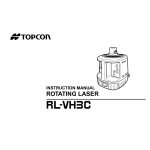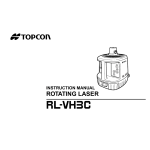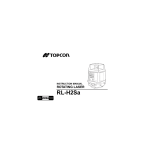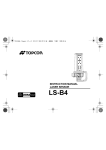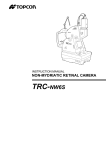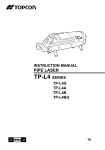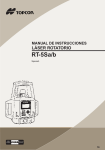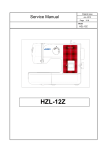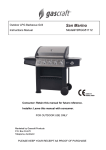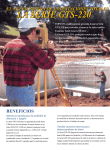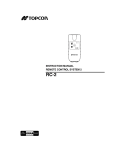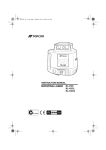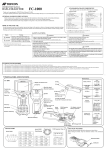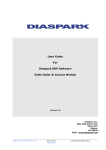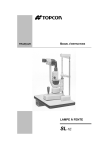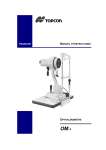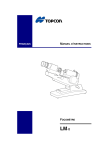Download SERIES DIGITAL LEVEL
Transcript
INSTRUCTION MANUAL DIGITAL LEVEL SERIES Foreword Thank you for purchasing the TOPCON Electronic Digital Level DL-103 series. For the best performance of the instruments, please carefully read these instructions and keep them in a convenient location for future reference. EXCEPTIONS FROM RESPONSIBILITY 1)The user of this product is expected to follow all operating instructions and make periodic checks of the product’s performance. 2)The manufacturer,or its representatives, assumes no responsibility for results of a faulty or intentional usage or misuse including any direct, indirect, consequential damage, and loss of profits. 3)The manufacturer, or its representatives, assumes no responsibility for consequential damage, and loss of profits by any disaster, (an earthquake, storms, floods etc.).A fire, accident, or an act of a third party and/or a usage any other usual conditions. 4)The manufacturer, or its representatives, assumes no responsibility for any damage, and loss of profits due to a change of data, loss of data, an interruption of business etc., caused by using the product or an unusable product. 5)The manufacturer, or its representatives, assumes no responsibility for any damage, and loss of profits caused by usage except for explained in the user manual. 6)The manufacturer, or its representatives, assumes no responsibility for damage caused by wrong movement, or action due to connecting with other products. 1 GENERAL HANDLING PRECAUTIONS 1) Staff Precautions are needed to avoid to be dirt or hurt of Pattern Staff surface or connected part of each staff. The pattern surface or the connected part is possible to be touched and injured on the occasion of storage or transportation. If the patterns dirtied or injured, accurate read out or measurement can not be expected because the instrument reads out the white and black patterns of the staff as electrical signals. Otherwise the quality of accuracy of the instrument reduces or sometimes measurement can not be done. 2) Tripod The screws on each leg of the tripod must be tightened firmly. 3) On tribrach If tribrach is not installed correctly, measuring precision may be effected. Occasionally check adjusting screws of the tribrach . Tighten the Base Fixing Screw. 4) Guarding the instrument against shocks When transporting the instrument, provide some protection to minimize risk of shocks. Heavy shocks may cause the measurement to be faulty. 5) Carrying the instrument When carrying the instrument at the site, always grip its handgrip. 6) Do not expose the instrument directly to the sunlight Never leave the instrument in extreme heat (+122 degrees F) longer than necessary. Heat can adversely affect its performance. Never expose the instrument's objective lens to direct sunlight without a filter. Sunlight may damage the components inside the instrument. 7) Sudden changes of temperature Any sudden change of temperature to the instrument may result in a reduction of the measuring range. When taking the instrument out from a heated vehicle let instrument acclimate itself to the ambient temperature. 8) Battery level check Confirm battery level remaining before operating. 2 DISPLAY FOR SAFE USE In order to encourage the safe use of products and prevent any danger to the operator and others or damage to properties, important warnings are put on the products and inserted in the instruction manuals. We suggest that everyone understand the meaning of the following displays and icons before reading the “Safety Cautions” and text. Display Meaning WARNING Ignoring or disregard of this display may lead to the danger of death or serious injury. CAUTION Ignoring or disregard of this display may lead to personal injury or physical damage. • Injury refers to hurt, burn, electric shock, etc. • Physical damage refers to extensive damage to buildings or equipment and furniture. SAFETY CAUTIONS WARNING • Cause eye injury or blindness. Do not look at the sun through a telescope. • Risk of fire or electric shock. Do not use a wet battery . • Battery can cause explosion or injury. Do not dispose in fire or heat. • May ignite explosively. Never use an instrument near flammable gas, liquid matter, and do not use in a coal mine. • The short circuit of a battery can cause a fire. Do not short circuit battery when storing it. • Keep the pattern staff away from electric facilities such as a high voltage wire or substation. As this is an electric conductor, there is danger of electric shock. • Do not use the pattern staff in conditions of thunder and lightening. As this is an electric conductor, thunderbolt can cause serious injury or death. 3 CAUTION • Risk of injury by overturn the carrying case. Do not stand or sit on the carrying cases. • Please note that the tips of tripod can be hazardous, be aware of this when setting up or carrying the tripod. • Risk of injury by falling down the instrument or case. Do not use a carrying case with a damaged which belts, grips or latches. • Do not allow skin or clothing to come into contact with acid from the batteries, if this does occur then wash off with copious amounts of water and seek medical advice. • A plumb bob can cause an injury to a person if used incorrectly. • It could be dangerous if the instrument falls over, please ensure you attach a handle to the instrument securely. • Risk of injury by falling down a tripod and an instrument. Always check that the screws of tripod are tightened. USER • This product is for professional use only! The user is required to be a qualified surveyor or have a good knowledge of surveying, in order to understand the user and safety instructions, before operating, inspecting or adjusting. • Wear the required protectors ( safety shoes, helmet, etc. ) when operating. 4 CONTENTS STANDARD SYSTEM COMPONENTS ............................5 NOMENCLATURE AND FUNCTIONS..............................6 Nomenclature............................................................6 Operating Keys and Functions ..................................7 Display.......................................................................8 PREPARATION FOR MEASUREMENT............................9 Using the Battery Box ...............................................9 Setting Up the Instrument for Measurement .............9 Focusing..................................................................12 Battery Supply Switch ON and Changing Mode .....15 Battery Power Remaining Display ...........................15 MEASUREMENT ...........................................................16 Measurement Mode(Rod / Distance) ......................16 Height Difference Mode...........................................17 Measuring a Horizontal Angle .................................18 SETTING MODE.............................................................19 Items of the setting mode........................................19 Setting Example ......................................................20 Data Format ............................................................21 CHECKING AND ADJUSTMENT ...................................22 Adjustment of Circular Level ...................................22 Adjusting Mode .......................................................23 ERROR ABOUT INSTRUMENT .....................................25 OPTIONAL ACCESSORIES ...........................................26 SPECIFICATIONS...........................................................27 STANDARD SYSTEM COMPONENTS 1) 2) 3) 4) 5) 6) 7) 8) Instrument DL-103AF (with lens cap).................... 1 pc. Carrying case ......................................................... 1set AA dry battery ........................................................ 4 pc. Silicon cloth ............................................................ 1 pc. Plastic rain cover .................................................... 1 pc. Plumb bob set ........................................................ 1set Hexagon wrench .................................................... 1 pc. Instruction manual .................................................. 1vol. Make sure that all of the above items are with the instrument when purchased. 5 NOMENCLATURE AND FUNCTIONS Nomenclature Lock lever Objective lens Battery box Horizontal tangent screw Leveling screw Base Hand grip Reticle cover AF/MF Changing knob Eyepiece ring MF Focusing knob AF Eyepiece lens Measuring key RS-232C Connector 6 Circular level mirror Height Difference key Circular level Distance/ Rod key LCD Lighting key POWER key Display Operating Keys and functions Key Function POWER key Power supply is on or off. Measuring key Measurement is started. HDif key • Measurement mode and Height Difference mode is changed. • Measuring Height Difference, reference height is removed. Distance/ Rod key Distance and rod is changed. LCD Lighting key Display is lighted up for ten minutes. 7 Display Display Mode Battery Power Remaining Focus 1.2345m Measurement Unit (m, ft, fi) Measurement Result Rod Staff reading Dist Distance or Height Difference Mode Display Meas HDif 8 Modes Measurement Mode Height Difference Mode Adj Adjustment Mode Set Set Mode PREPARATION FOR MEASUREMENT Using the Battery Box How to remove the Battery Box Push down the lock lever to remove the bttery. Lock Lever Battery box How to install the Battery Install four AA dry batteries in the battery box referring to illustration of plus and minus. How to install the Battery Box Place the base of the battery box into the main body, push the battery box toward the instrument side till the battery clicks into position. Setting Up the Instrument for Measurement Setting up the Tripod Use a tripod with a tripod screw of 5/8" diameter and 11 threads per inch. 1 Extend the legs to a suitable length and tighten the wing nuts at the legs mid-sections. 2 Tighten the hexagonal nut located on the side of the tripod head such that the tripod legs are not too loose. Place the tripod over the required point, with the legs spread about a meter apart or at such an angle to insure the stability of the tripod. Place one tripod leg in position and then used the other two legs to approximately level the tripod head. If necessary adjust the tripod leg extension. 3 Press the shoes of the tripod legs firmly into the ground to anchor the tripod securely. 9 Attaching the Instrument to the Tripod Head Take the instrument carefully out of the carrying case and place it on the tripod head. 1 Align the tripod screw with the socket on the base of the instrument, and screw in the tripod screw until the instrument is securely fixed to the tripod head. 2 If the horizontal circle is being used for measuring an angle or establishing a line, the instrument must be set up exactly over the point with the plum bob. 3 Use the three leveling screws to center the circular bubble level in other to level the instrument. If a dome head tripod is being used, loosen the tripod screw slightly and move the instrument around on top of the tripod head to center the circular level bubble vial. When the bubble is within the red circle, tighten the tripod socket. Setting the Instrument Up Over the Point When the instrument is used to measure angles or to establish a line, the instrument must be set up exactly over a particular point with the plumb bob. 1 Hang the plumb bob hook on the plumb bob hanger of the tripod screw. 2 Next suspend the plumb bob string from the plumb hook and adjust the string length with the slipping device so that the plumb bob is at a suitable height. 3 If the instrument is not set up over the required point, move the instrument over the point without disturbing the relation between the tripod legs and the tripod head. Place the tripod in position so that the plumb bob is within one centimeter or so of the point. Grasp two of the tripod legs and adjust with respect to the third leg so that the tripod head is level at a convenient height with sufficient spread of the legs when the two legs are allowed to touch ground. 4 Finally press each leg firmly into the ground while watching the plumb bob and tripod head. 5 Loosen the tripod screw slightly and slide the instrument on the tripod head in order to position the plumb bob directly over the point and tighten the tripod screw. 10 Leveling the Instrument by the circular level By using circular level mirror, the position of the bubble can be checked from the direction of the display. 1 Use the two leveling screws furthermost from the circular level to move the bubble of the circular level vial. Rotate the screws in the direction which will shift the bubble of the circular level vial so that the bubble is located on a line perpendicular to a line running through the center of the two leveling screws being adjusted, as illustrated. 2 Next, revolve the remaining leveling screw to shift the bubble towards the center of the circular level vial. 1 Leveling screw C ↓ 2 Leveling screw A Leveling screw B 11 Focusing You can select focusing method between manual or auto as showing illustrator for your device. Changing AF/MF To change AF to MF, push the AF/MF changing knob and turn to clockwise. The display shows “M” during measurement. AF/MF Changing knob MF AF Manual Focus To change MF to AF, turn the AF/MF changing knob to the counterclockwise and pull it. The display shows “A” during measurement. MF AF Auto Focus Also you can change focusing system from AF to MF or conversely during measurement. Collimating 1 2 12 Point the telescope in the direction of the target. Sight through the telescope and align the target to the apex of the triangular mark as illustrated. Next, revolve the focusing knob in either direction until the target is in focus. Target Sight Focusing knob Measuring key Power key 3 4 Eyepiece ring Adjust to be focusing Manual focusing Turn the focusing knob to fit to the staff line in manual focusing. Auto focusing Pressing measuring key after power ON, telescope will be focus to the staff line automatically. Finally, use the horizontal tangent screw for precise alignment of the target. 1)You will find small gap in focusing image during Auto focusing in rare case, this is no problem in measuring accuracy. 2)Accurate focusing in manual focusing will help to be shorter for measuring time. Note Once the level has been focused and aligned on the target, shift the eye to the left and right while looking through the telescope eyepiece. There should be no deviation between the reticle cross-hairs and the target. If there is deviation, parallax, then either focus the instrument or adjust eyepiece. Effective range of Auto focusing Effective of Auto focusing range can be on the vertical line of cross hair in the telescope. Set the required target on the vertical line of cross hair. Auto focusing using other than Pattern Staff In case the target to be focused shows extremely small contrast between light and shade, focusing accuracy can be poor so it is better that you select high contrast as a target. 13 STAFF Use a staff of TOPCON made by all means. Obstructions As long as the staff is not hidden by obstructions, such as tree branches by more than 30percent, measurement can be taken. Even if the point of intersection of the cross-hair is obscured, measurements can be taken if the obstruction covers less than 30 percent of the view. Measuring is possible Measuring is possible Measuring is impossible Measurement is impossible even through the point of intersection of cross-hair is not hidden. Shadow It may not be possible to rarely measure when the staff is covered with a shadow as shown below. In that case, cover the whole of the staff with a shadow. → Cover the whole of the staff with a shadow. 14 Measuring Precaution The followings are offered to take over full functions from the unit. 1 Set up the staff in the sufficient daylight. Even the illumination is used whole the staff should be illuminated. 2 The minimum distance possible measurement between instrument and staff is 2m. 3 No matter in measuring functions if the staff is in the shade, but if the scale pattern is covered by the shadow of tree branch or leaf, error may displays and measuring will be disturbed. 4 Precautions are needed to avoid to be dirt or hurt of Pattern Staff surface or connected part of each staff.When the staff becomes corrupt, wipe with a clean wet cloth after removing soil and the dust.Avoid the use of thinner or benzine. 5 Avoid waving of pattern staff in case electrical reading measurement. Use level of pattern staff. Battery supply switch ON and Changing Mode When the battery supply switch (power key) is ON , the display indicates measurement mode or height difference mode which is a state of the last time. Changing Measurement Mode / Height Difference Mode. Push the [HDif] key to change measurement mode and height difference mode each other. Battery Power Remaining Display Battery Icon The battery icon displays the battery capacity. The battery level is sufficient for measuring. The battery level is sufficient for measuring. The battery level is for measuring. The battery will soon be discharged. Charge to a new battery as soon as possible. 15 MEASUREMENT Measurement Mode(Rod / Distance) 1 Check the instrument to be measurement mode. 2 Collimate the staff at the measuring point. Push the [Meas] key. Measurement is started. (Then the instrument measures rod and distance at same time.) After measurement is completed, a result is displayed. 1.2345m 3 Push the [D/R] key to change the result to distance or rod. The result is changed to distance or rod each other. 12.34m 16 Height Difference Mode 1 By using the staff, measure the height of the reference point. 1.2345m 2 Push the [HDif] key to memorize the height of the reference point. Then the display indicates ”Recorded”. 3 Collimate the staff of next measurement point. Push the [Meas] key. After measuring, the height difference is displayed. Then the measurement point is higher than the reference point, mark is indicated.The measurement point is lower than the reference point, mark is indicated. 0.1234m 4 Push the [D/R] key, the display changes as follows. HDif→Rod→ Dist 1.2345m 5 Press the [HDif] key to return Rod / Distance measurement. 1.2345m 17 Measuring a Horizontal Angle This instrument has a horizontal circle which can be used to measure horizontal angles. The horizontal circle is graduated in 1° (1g) divisions and is numbered every 10° (10g), with the scale calibrated from 0° to 350° (0 to 390g). The angular value increases as the instrument is revolved clockwise. Horizontal circle 1 2 First, set up and level the instrument over the starting point, point C. Then sight through the telescope on the backsight, point A. Align the rod on point A precisely to the vertical cross-hair using the horizontal tangent screw. Rotate the horizontal circle ring until zero is set on the scale. Next, sight through the telescope on the rod held on point B and precisely align with the horizontal tangent screw. The angular reading will be the horizontal angle between points A and B from point C, the angle ACB. Point A Point B 10 0 350 Point A 40 30 Point B 20 Degree type Point C 10 0 390 Point A Horizontal angle: 30 ° or 33g 18 40 30 Point B Grade type 20 SETTING MODE Items of the setting mode The following modes are available. Refer to the next page to set the items. Items Selecting Set Fix Standard / Precise Display Unit RS-232C Set Termination Auto Cut OFF m / ft / fi Contents Select the minimum reading Standard or Precise. Select the distance measurement unit shown on the display. ON / OFF Select the RS-232C ON or OFF for data output. CRLF ON / OFF Select the option ON or OFF for termination code. (ON→ETXCRLF, OFF→ETX) OFF / 30min. The auto cut off option can be turned OFF or set ON (30 minutes). 19 Setting Example Auto Cut OFF 1 2 While pressing the [D/R] key, press the power switch to set the indicator setting mode. Press the [HDif] key to change the indicator “Auto Cut off”. 3 Press the [D/R] key. The position of the cursor indicates setting condition then. Cursor 4 Press the [HDif] key to select “30min”. (In case of “OFF” is selected, auto cut off function is canceled.) 5 6 Press the [D/R] key to settle the term. Turn the power switch off. Display Unit 1 2 While pressing the [D/R] key, press the power switch to set the indicator set mode. Press the [HDif] key to change the indicator “Display unit” 3 Press the [D/R] key.The position of the cursor indicates setting condition then. 4 Press the [HDif] key to select “ft”. 5 6 Turn the power switch off. 20 Press the [D/R] key to settle the term. RS-232C 1 2 While pressing the [D/R] key, press the power switch to set the indicator set mode. Press the [HDif] key to change the indicator “RS-232C”. 3 Press the [D/R] key. The position of the cursor indicates setting condition then. 4 Press the [HDif] key to select “ON”. 5 6 Press the [D/R] key to settle the term. Turn the power switch off. Data Format Result of measurement can be transferred to PC from DL-103AF. To transfer the Rod and Distance data, DL-103AF should be set RS232C on and the measurement mode (Rod / Distance). Character format is fixed.(except termination code) Baud rate 1200BPS Start bit 1bit (“0”=high) Data bit 7bit (“0”=high, “1”=low) Parity even number (“0”=high, “1”=low) Stop bit 1bit (“1”=low) Termination code ETX / ETXCRLF For more information about connecting with the instrument, refer to DL-103 interface manual . 21 Checking and Adjustment Adjustment of Circular Level Check 1 2 Set the instrument on the tripod and carefully center the bubble of the circular level with the three leveling screws. Revolve the telescope 180°around its vertical axis. If the bubble moves from the center, adjustment must be made as follows. Adjustment 1 2 3 First, pick the level vial adjust screw that the bubble has moved toward. Then tighten the circular level adjustment screw. Return the bubble only one-half the amount of the total error. Recenter the circular level bubble with the three leveling screws. The bubble should now remain centered as the telescope is revolved around its axis. If the bubble does not remain centered then the above adjustment should be repeated until the bubble remains centered when the instrument is revolved around its axis. Circular level adjustment screw 22 Adjusting Mode Adjust the instrument by the following steps. 1 Set the instrument at the center between staff A and B. Center the bubble of the circular level with the three leveling screws. STAFF B STAFF A Approximately 15m 2 Approximately 15m 3 While pressing the [HDif] key, press power switch to set the indicator adjustment mode. Collimate the staff A and push the [Meas] key. (step1) 4 Collimate the staff B and push the [Meas] key. (step2) 5 Set the instrument at the position that is approximately 3m apart from the staff A.Center the bubble of the circular level again with the three leveling screws. STAFF B STAFF A Approximately 3m Approximately 27m 23 6 Collimate the staff A and push the [Meas] key. (step3) 7 Collimate the staff B and push the [Meas] key. (step4) 8 The complemented value (electrical reading pattern) is displayed. +3.5mm Press the [D/R] key to set displayed electrical adjustment value, then the software indicates the rod value that should be complemented for the reticle adjustment. 1.234m 9 Here the electrical adjustment is completed, however, we recommend to check the optical reading (Reticle adjustment) with the following procedure always when the electrical adjustment is performed. Reverse the staff B to be optical reading pattern side. Take the reticle cover off. Adjust the reticle adjustment screws by using the hexagon wrench till the reticle is complemented height. In case that the reticle adjustment is ensured prior to above electrical adjustment, you can skip this step 9 and turn off the instrument. Reticle Reticle adjustment screw 10 24 Turn off the power supply. ERROR ABOUT INSTRUMENT Display Explanation Comp Err The inclination of the instrument exceeds the capacity of the compensator. Level the instrument properly. Dark Err The level cannot read the rod due to lack of light. The data will have to be entered manually until lighting has improved. Light Err The level cannot read the rod due to an excess of light such as direct sunlight or glare. Remove the source of the sunlight or glare from the objective lens. ROM Err This message is displayed when any abnormality occurs with internal memory. Turn the power switch off then on again. CCD Err Any abnormality occurs within the CPU. Turn the power switch off then on again. No Staff Level is not properly sighted on the staff. Collimate the staff properly. Meas Err • The distance between the instrument and the staff is either too far or near. • The distance between the instrument and the staff should be within the range of 2m to 60m. (Fiberglass staff) • Remove the obstructions. • The staff is obstructed by more than 30 percent. Countermeasure • The cross-hairs are not within the range of the staff. • The staff should be within the range of the cross-hairs. Any abnormality occurs within the CPU. Turn the power switch off then on again. Communication Error Confirm the setting of communication and try to communicate again. Coll Err An invalid value has been collected during the adjustment process. Start the adjustment procedure from the beginning. Opr Err Level is not properly sighted during the adjustment process. Start the adjustment procedure from the beginning. Setting Err Level is not set approximately during the adjustment process. Set the instrument approximately Start the adjustment procedure from the beginning. Focus Err Auto focus does‘t function precisely. Measure again. But auto focus doesn‘t function precisely, use manual focus. CPU Err COMM Err If errors still persist after attempting to clear them, contact your local TOPCON dealer. 25 Optional Accessories Aluminum Staff SA-5M (5m) Fiber Staff SG-3M/ 3F/ 3I (3m) Dome Head Aluminum Extension Leg Tripod QM-1D Dome Head Aluminum Extension Leg Tripod QM-3D Aluminum Extension Leg Tripod DM-1 Aluminum Extension Leg Tripod DM-3 26 SPECIFICATIONS Telescope Magnification Image Objective aperture Field of view Resolving power Minimum focus : : : : : : 26X~ Erect 30mm 1° 30' 4" 0.9m Compensator Working range Setting accuracy : ±10' : ± 5" Height Measurement Accuracy (Standard deviation for 1km) Electrical reading Optical reading Least count Measuring range : ±1.8mm (Staff SG-3M/ 3F/ 3I) : ±2mm (Staff SA-5M+Circular level) : ±2.5mm : 0.1mm : 2m ~ 60m Distance Measurement Minimum reading Accuracy (D: Measurement distance) Measuring range Measuring Time (daytime) (+20 °C / +68°F) Circular level sensitivity Others : 1cm : ±(0.1%xDm) (D>10m) ±10mm(D≤10m)(Staff SG-3M/ 3F/ 3I) : ±(0.15%xDm) (D>10m) ±15mm (D≤10m) (Staff SA-5M+Circular level) : 2m ~ 60m : Approximately 2sec.(ManualFocus) : Approximately 4sec.(Auto Focus) : 10'/ 2mm Display Horizontal Circle Power Supply Operating Time (+20°C / +68°F) : : : : : 128x32 Dot matrix LCD 360°or 400gon 4 AA Dry battery 16 hours (Manual Focus) 10 hours (Auto Focus) Ambient Temperature Range Water protection Dimensions(D/W/H) : -20°C~+50 °C (-4°F to +122°F) : Water proof(IPX 4) : 196x168x232mm (7.7x6.6x9.1 inch) : 2.4kg (5.3lbs) (Alkaline manganese dry battery) Weight 27 Notes TOPCON CORPORATION 75-1 Hasunuma-cho,Itabashi-ku,Tokyo,174-8580 Japan Phone:3-3558-2520 Fax:3-3960-4214 TOPCON AMERICA CORPORATION CORPORATE OFFICE 37 West Century Road, Paramus, New Jersey 07652, U.S.A. Phone: 201-261-9450 Fax: 201-387-2710 www.Topcon.com TOPCON CALIFORNIA 3380 Industrial BLVD, Suite 105, West Sacramento, CA 95691, U.S.A. Phone: 916-374-8575 Fax: 916-374-8329 TOPCON MIDWEST 891 Busse Road, Elk Grove Village, IL 60007, U.S.A. Phone: 847-734-1700 Fax: 847-734-1712 TOPCON DENVER 109 Inverness Dr, E Uniti Englewood, CO 80112, U.S.A. Phone: 303-706-0920 Fax: 303-706-0921 TOPCON LASER SYSTEMS, INC. 5758 West Las Positas Blvd., Pleasanton, CA 94588, U.S.A. Phone: 925-460-1300 Fax: 925-460-1315 www.topconlaser.com TOPCON EUROPE B.V. Esse Baan 11, 2908 LJ Capelle a/d IJssel, The Netherlands. Phone: 010-4585077 Fax: 010-4585045 www.topconeurope.com TOPCON BELGIUM Preenakker 8, 1785 Merchtem, Belgium Phone: 052-37.45.48 Fax: 052-37.45.79 TOPCON DEUTSCHLAND G.m.b.H. Halskestr. 7, 47877 Willich, Germany. Phone: 02154-9290 Fax: 02154-929-111 Telex: 8531981 TOPC D TOPCON S.A.R.L. 104/106, Rue Rivay 92300, Levallois-Perret, France. Phone: 01-4106 9494 (MEDICAL) 1-4106 9490 (TOPOGRAPHIE) Fax: 01-47390251 TOPCON ESPAÑA S.A. HEAD OFFICE Frederic Mompou 5, 08960, Sant Just Desvern Barcelona, Spain. Phone: 93-473-4057 Fax: 93-473-3932 MADRID OFFICE Avenida Ciudad de Barcelona 81, 1 Planta 28007, Madrid, Spain. Phone: 91-552-4160 Fax: 91-552-4161 TOPCON SCANDINAVIA A. B. Industrivägen 4 P. O. Box 2140 43302 Sävedalen Sweden. Phone: 031-261250 Fax: 031-268607 Telex: 21414 TOPCON (GREAT BRITAIN) LTD. HEAD OFFICE Coach House, London Road, Hurst Green,EastSussexTN19 7QP U.K. Phone: 01580-860801 Fax: 01580-860802 TOPCON SINGAPORE PTE. LTD. Alexandra Distripark Block 4, #05-15, Pasir Panjang Road, Singapore 118491 Phone: 2780222 Fax: 2733540 E-mail: [email protected] TOPCON AUSTRALIA PTY. LTD. 408 Victoria Road, Gladesville, NSW 2111, Australia Phone: 02-9817-4666 Fax: 02-9817-4654 TOPCON INSTRUMENTS (THAILAND) CO., LTD. 77/162 Sinn Sathorn Tower, 37th Fl., Krungdhonburi Rd., Klonglonsai, Klongsarn, Bangkok 10600 Thailand. Phone: 662-440-1152~7 Fax: 662-440-1158 TOPCON INSTRUMENTS (MALAYSIA) SDN. BHD. Lot 226 Jalan Negara 2, Pusat Bandar Taman Melawati, Taman Melawati, 53100, Kuala Lumpur, Malaysia. Phone: 03-4079801 Fax: 03-4079796 TOPCON KOREA CORPORATION Hyobong Bldg., 1-1306, Seocho-Dong, Seocho-Gu, Seoul, Korea. Phone: 02-3482-9231 Fax: 02-3481-1928 TOPCON OPTICAL (H.K.) LIMITED 2/F., Meeco Industrial Bldg., No. 53-55 Au Pui Wan Street, Fo Tan Road, Shatin, N.T., Hong Kong Phone: 2690-1328 Fax: 2690-2221 E-mail: [email protected] TOPCON CORPORATION BEIJING OFFICE Room No. 962 Poly Plaza Building, 14 Dongzhimen Nandajie, Dongcheng District, Beijing, 100027, China Phone: 10-6501-4191~2 Fax: 10-6501-4190 TOPCON CORPORATION BEIRUT OFFICE P. O. BOX 70-1002 Antelias, BEIRUT-LEBANON. Phone: 961-4-523525/961-4-523526 Fax: 961-4-521119 TOPCON CORPORATION DUBAI OFFICE Offce No. 102, Khalaf Rashd AI Nayli Bldg., 245 Abu Hail Road, Deira, Dubai, UAE Phone: 971-4-696511 Fax: 971-4-695272 31810 9021 TOPCON DL-103AF 9906 (1) NA
































